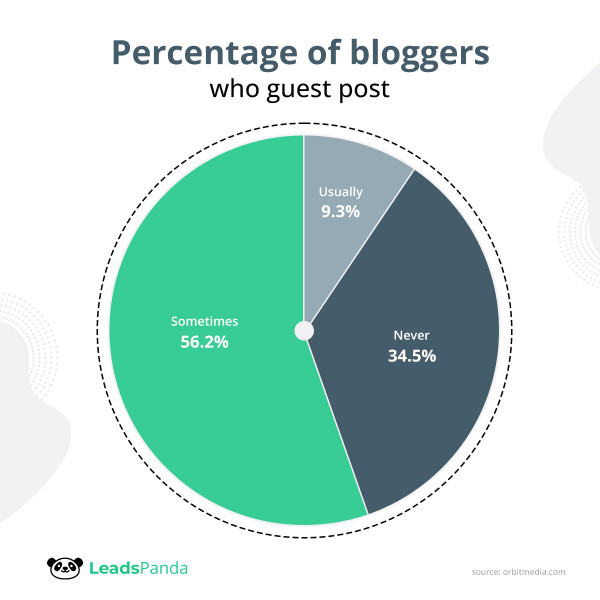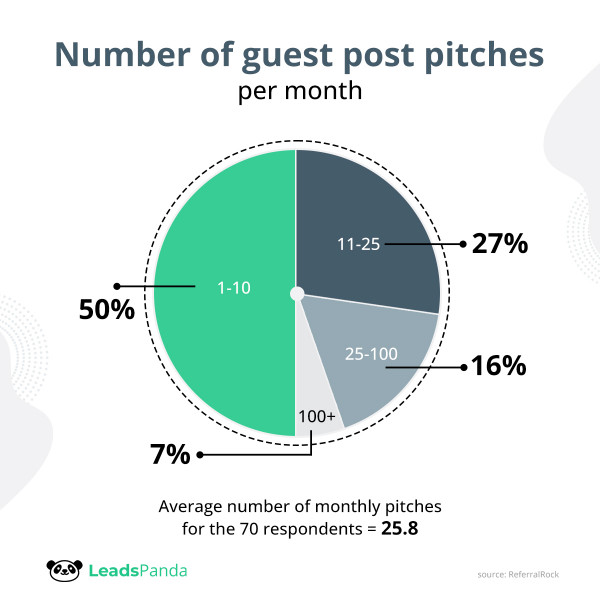How to Start Guest Blogging in 6 Easy Steps
In 2014, Google’s then head of web spam Matt Cutts boldly made this statement:
“Okay, I’m calling it: if you’re using guest blogging as a way to gain links in 2014, you should probably stop.”
Because of this statement, guest posting or guest blogging, then recognized as an effective way to establish credibility and build your online presence among like-minded audiences, began to lose its appeal for some.
Take note, however, of how Cutts phrased his answer—“using guest blogging as a way to gain links.” Then and now, gaining links should never be your only reason for guest blogging. Sure, gaining legitimate backlinks is a big benefit, but your objective should primarily be to write a targeted, highly relevant article for a new audience.
Great content, at the end of the day, is still king—that’s why guest blogging is used today. In fact, 60% of blogs produce one to five guest posts per month. Additionally, 62% of readers think blogs with multiple authors are more credible.
Basically, if you’re using guest posting as a way to send out articles with link-stuffed, barely-researched content that’s spammy and uninformative, then we have to agree with Mr. Cutts—you should indeed probably stop. But if you’re using guest blogging as a way to build and deliver awesome content to more readers, then you will reap benefits.

How do you start guest blogging—the right way? Let’s break it down in these six easy steps:
1. Establish your overall goal for guest blogging
You can’t just randomly start emailing major websites in your niche and hope to get noticed. Guest blogging isn’t as simple as sending an email to a major publication like Forbes and getting your article published.
Like most things in content marketing, guest blogging has to be backed by a solid plan rooted in clear goals.
Your goals will vary depending on what metrics you’re trying to build. You may want to guest blog to drive traffic to a specific page on your site such as a blog post or a landing page. It could be that you want to build credibility by being associated with other thought leaders in your niche. You may also want to establish better authority on social media by having a post that can help you boost social media engagement.
2. List sites you want to target
With these goals in place, you’ll now have a clearer picture of publications you can reach out to.
At this stage, you have to be very conscious about the publications you’re choosing. Just because they’re popular doesn’t mean that they’re necessarily the best choices for a guest blog.
Keep the following questions in mind when you’re whittling down your list:
- Is the site relevant to your brand or business?
- Will their audience find the topics you intend to write about relevant?
- Is the site a recognized authority in your niche?
- Does the site accept guest blog submissions?
- Do they have guidelines and submission information you can refer to?
If you answered yes to all these points, then it’s fairly safe to add them to your guest blog outreach list.
3. Establish rapport with site owners
Knowing your objectives and armed with your list of potential publications, it’s time to start reaching out to the editors or site owners of the sites you have shortlisted.
This is where it gets a little tricky. Very rarely does cold calling achieve favorable results. So if you want to catch the attention of a known editor or site owner you want to publish with, here are a few ways you can get on their radar:
- Start following them on social media.
- Share their content and tag them when you do.
- Comment or engage with them on their posts.
- Curate their content for your own blog and link to them.
Why go through all this trouble? Because you don’t just want a high-authority backlink. You’re planting the seeds of a lasting relationship that may lead to more opportunities in the future. It could be a guest blog now, but who’s to say you can’t collaborate on future content?
4. Pitch your ideas and always follow best practices when you do
At this point, you should be familiar with how a particular site works and operates their guest posting program. But before you make your pitch, start by reading their submission guidelines.
Always send a personalized message when you reach out. Address the editor or site owner by their name and mention something specific about their content. Have you read an article they published that resonated with you? Did they post something on social media that helped build your audience? Share these details with them to establish a connection and rapport.
You also want to demonstrate your credibility as a potential guest author for their site. Don’t approach with half-baked, generic ideas. Instead, take the time to craft unique story angles that can make a lasting impression. Review their site and check for topics they have already written about and find gaps you can fill with your unique perspective.
5. Follow up
Even after you do all the initial work, you probably won’t get a reply. When that happens, it’s perfectly OK to follow up. They probably get a lot of these requests daily so give it some time and if you still haven’t received a response, reach out with a follow-up message.

Think of it as you giving them a little nudge to get a response. When you do, you can highlight the value of your contribution for both their site and their audience.
6. Write and submit your article
Once the editor or site owner approves one of your angles, it’s time to start writing. Be sure to submit copy that is well researched, well written, publish-ready and that follows all their submission guidelines in terms of tone and formatting.
There might be a bit of back and forth at this stage, just to fine tune your content for the site, but once they accept it, you just have to wait until they publish your piece.
Simple enough? Give it a try and let us know how it works out for you. If you want to learn more, reach out to us. Book a consultation or get started with LeadsPanda to find out how we can help you get a guest blogging program started for your brand.
For any questions, leave a comment below or check out our LinkedIn or Twitter.
Share This Story
Get the latest growth ideas, strategies, and best practices delivered to your inbox.
Quick read that helps 7000+ subscribers.








